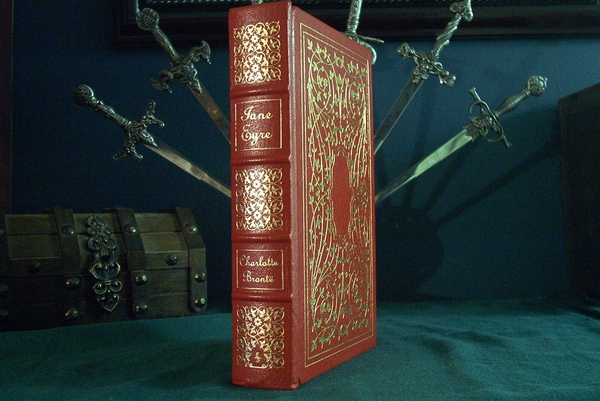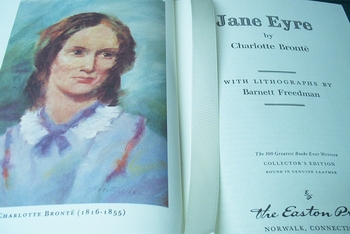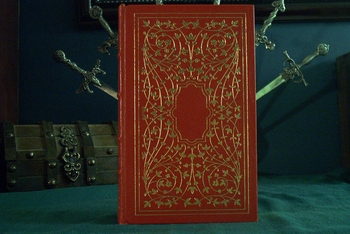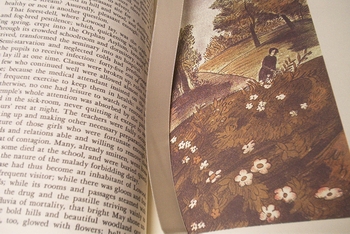Easton Press Charlotte Brontë books
Jane Eyre - 100 Greatest Books Ever Written - 1978Franklin Library Charlotte Brontë books
Jane Eyre - World's Best Loved Books - 1980
Jane Eyre - 100 Greatest Books of All Time - 1981
Jane Eyre - 100 Greatest Books of All Time - 1981
Jane Eyre - Oxford Library of The World's Greatest Books - 1981
Charlotte Brontë biography
Charlotte Brontë, born on April 21, 1816, in Thornton, West Yorkshire, England, was an English novelist and one of the most celebrated writers of the 19th century. She was the eldest of the three Brontë sisters, with Emily and Anne also achieving literary fame. Charlotte's life was marked by a blend of creativity, tragedy, and a determined pursuit of her passion for writing. The Brontë family faced considerable challenges, including the early deaths of Charlotte's mother and two older sisters. Despite these hardships, Charlotte and her siblings—Emily, Anne, and Branwell—found solace in their shared love for literature and storytelling. They created a rich imaginary world, Gondal, which became an early foundation for their future literary endeavors. In 1842 Charlotte and Emily spent eight months in a school in Brussels, Belgium, where, in 1843, Charlotte taught English. All three Brontë sisters had been writing verses, each concealing her work from her sisters. In 1845 they became aware of each other’s secret efforts and, in the following year brought out at their own expense a volume of their poems, under the pseudonyms Currer, Ellis, and Acton Bell. The book attracted little notice; only two copies were sold.
Charlotte attended the Clergy Daughters' School at Cowan Bridge, an experience that influenced her later novel Jane Eyre. After completing her education, she worked as a governess and a teacher, experiences that informed her understanding of social class and gender roles, prevalent themes in her novels.
In 1847, Charlotte published Jane Eyre, under the pseudonym Currer Bell. The novel, a bildungsroman exploring the moral and spiritual development of its protagonist, Jane Eyre, was an immediate success. Its exploration of social issues, such as gender inequality and the treatment of the poor, resonated with Victorian readers. Following the success of Jane Eyre, Charlotte wrote several other novels, including Shirley (1849) and Villette (1853). Charlotte Brontë’s novel Jane Eyre, containing a fictional account of her unhappy experience at the school for clergymen’s daughters, was published in August, 1847, and met with immediate success. Emily Brontë’s grim and tragic novel Wuthering Heights, set in the bleak Yorkshire moors, and Anne’s partly autobiographical novel of her unpleasant experience as a governess, Agnes Grey, were both published in December 1847. Anne’s second work, The Tenant of Wildfell Hall, appeared in 1848. Charlotte Brontë's novel Shirley (1849) was an idealized portrait of her sister Anne, and her Villette (1853) was based on her experiences in Brussels. The year before her death Charlotte married her father’s curate, Arthur Bell Nicholls.
While Jane Eyre remains Charlotte Brontë's most famous work, Villette has gained appreciation over the years for its unique narrative style and the compelling portrayal of its central character.
Her works often dealt with themes of love, morality, and the struggles of individuals, particularly women, in the rigid social structures of the time. Tragedy struck the Brontë family again with the deaths of Branwell, Emily, and Anne in rapid succession. Charlotte found herself the sole surviving sibling. In 1854, she married Arthur Bell Nicholls, her father's curate, but her own life was cut short. Charlotte Brontë died on March 31, 1855, during her pregnancy.
Charlotte Brontë's novels, known for their psychological depth and exploration of complex characters, have continued to captivate readers for generations. Her enduring legacy includes not only her contributions to English literature but also her role in challenging societal norms through her writings. Jane Eyre remains a literary classic, and Charlotte's life story is a testament to the enduring power of storytelling and the triumph of creativity over adversity.
The Professor
The Professor was her first novel, written before her more well-known works such as Jane Eyre, Shirley and Villette. The Professor was completed in 1846 but was not published until 1857, two years after Charlotte Brontë's death. The novel follows the story of William Crimsworth, an Englishman who travels to Belgium to work as a teacher. Much like Brontë herself, Crimsworth faces the challenges of living and working in a foreign country. The narrative explores themes of isolation, cultural differences, and the pursuit of personal and professional fulfillment. The Professor is distinct from Brontë's later works in its narrative style and tone. While it may not have gained the same level of popularity as Jane Eyre or Villette, the novel provides insights into Brontë's early writing and her exploration of themes that would become central to her later works.Charlotte attended the Clergy Daughters' School at Cowan Bridge, an experience that influenced her later novel Jane Eyre. After completing her education, she worked as a governess and a teacher, experiences that informed her understanding of social class and gender roles, prevalent themes in her novels.
In 1847, Charlotte published Jane Eyre, under the pseudonym Currer Bell. The novel, a bildungsroman exploring the moral and spiritual development of its protagonist, Jane Eyre, was an immediate success. Its exploration of social issues, such as gender inequality and the treatment of the poor, resonated with Victorian readers. Following the success of Jane Eyre, Charlotte wrote several other novels, including Shirley (1849) and Villette (1853). Charlotte Brontë’s novel Jane Eyre, containing a fictional account of her unhappy experience at the school for clergymen’s daughters, was published in August, 1847, and met with immediate success. Emily Brontë’s grim and tragic novel Wuthering Heights, set in the bleak Yorkshire moors, and Anne’s partly autobiographical novel of her unpleasant experience as a governess, Agnes Grey, were both published in December 1847. Anne’s second work, The Tenant of Wildfell Hall, appeared in 1848. Charlotte Brontë's novel Shirley (1849) was an idealized portrait of her sister Anne, and her Villette (1853) was based on her experiences in Brussels. The year before her death Charlotte married her father’s curate, Arthur Bell Nicholls.
Villette
Villette follows the protagonist, Lucy Snowe, an Englishwoman who travels to the fictional town of Villette to seek employment as a teacher. Set in the 1830s, the story explores themes of isolation, identity, and unrequited love. Lucy faces challenges and uncertainties as she navigates a new culture, language, and the complex social dynamics of Villette. Villette is known for its psychological depth and introspective narrative. The character of Lucy Snowe is complex, and the novel delves into her inner thoughts and emotions, providing a nuanced portrayal of a woman grappling with societal expectations and personal desires. One of the notable aspects of Villette is its ambiguity and open-ended conclusion, which has sparked discussions and interpretations among readers and literary scholars. The novel has been praised for its narrative complexity, the exploration of the limitations placed on women in the Victorian era, and its contribution to the genre of the bildungsroman.While Jane Eyre remains Charlotte Brontë's most famous work, Villette has gained appreciation over the years for its unique narrative style and the compelling portrayal of its central character.
Her works often dealt with themes of love, morality, and the struggles of individuals, particularly women, in the rigid social structures of the time. Tragedy struck the Brontë family again with the deaths of Branwell, Emily, and Anne in rapid succession. Charlotte found herself the sole surviving sibling. In 1854, she married Arthur Bell Nicholls, her father's curate, but her own life was cut short. Charlotte Brontë died on March 31, 1855, during her pregnancy.
Charlotte Brontë's novels, known for their psychological depth and exploration of complex characters, have continued to captivate readers for generations. Her enduring legacy includes not only her contributions to English literature but also her role in challenging societal norms through her writings. Jane Eyre remains a literary classic, and Charlotte's life story is a testament to the enduring power of storytelling and the triumph of creativity over adversity.
Jane Eyre
Orphaned into the household of her Aunt Reed at Gateshead, subject to the cruel regime at Lowood charity school, Jane Eyre nonetheless emerges unbroken in spirit and integrity.
She takes up the post of governess at Thornfield, falls in love with Mr. Rochester, and discovers the impediment to their lawful marriage in a story that transcends melodrama to portray a woman's passionate search for a wider and richer life than Victorian society traditionally allowed.
With a heroine full of yearning, the dangerous secrets she encounters, and the choices she finally makes, Charlotte Brontë's innovative and enduring romantic novel continues to engage and provoke readers.
She takes up the post of governess at Thornfield, falls in love with Mr. Rochester, and discovers the impediment to their lawful marriage in a story that transcends melodrama to portray a woman's passionate search for a wider and richer life than Victorian society traditionally allowed.
With a heroine full of yearning, the dangerous secrets she encounters, and the choices she finally makes, Charlotte Brontë's innovative and enduring romantic novel continues to engage and provoke readers.
Orphaned
as a child, Jane has felt an outcast her whole young life. Her courage
is tested once again when she arrives at Thornfield Hall, where she has
been hired by the brooding, proud Edward Rochester to care for his ward
Adèle. Jane finds herself drawn to his troubled yet kind spirit. She
falls in love. Hard.
But there is a terrifying secret inside the gloomy, forbidding Thornfield Hall. Is Rochester hiding from Jane? Will Jane be left heartbroken and exiled once again?
But there is a terrifying secret inside the gloomy, forbidding Thornfield Hall. Is Rochester hiding from Jane? Will Jane be left heartbroken and exiled once again?




Comments
Post a Comment
Share your best book review and recommendation